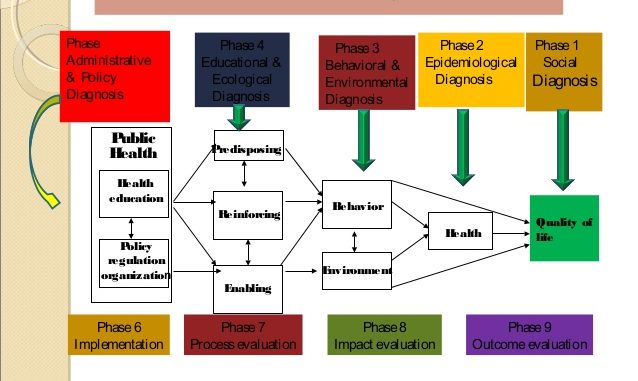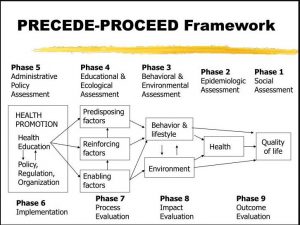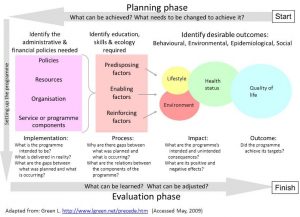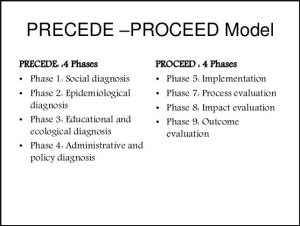
- Behavior is a characteristic of animal or human that can be observed.
- Behavioral change approach is a planned activity, interventions and strategies developed and carried out for bringing appropriate change in health behavior of people.
- There are different types of behavioral change models such as Health Belief Model, Theory of Planned Behavior, PRECEDE/PROCEED Model, Social Cognitive Theory
PRECEDE/PROCEED model
- PRECEDE/PROCEED model is a widely used model in public health for bringing change in behavior.
PRECEDE stands for:
P – Predisposing,
R- Reinforcing,
E – Enabling,
C – Construct in,
E- Educational,
D – Diagnosis and
E – Evaluation.
PROCEED Stands for:
P – Policy,
R – Regulatory,
O – Organizational,
C – Construct in,
E – Educational and
E – Environmental,
D – Development.
- PRECEDE model was put forward by Lawrence W. Green and colleagues in year 1970s. Further in year 1991, PROCEED was added to the model encompassing policy, regulatory and recognizing environmental factor as an important determinant of health and behavior of individuals.
- It emphasized on improving health of people by bringing change in health related behavior.
- This model is used for implementing programs and for carrying out behavior change interventions.
- PRECEDE/PROCEED model is used in planning, implementing and evaluating behavior change program in order to promote and protect health.
Purpose of PRECEDE/PROCEED model:
- It provides structural framework for developing behavior change intervention.
- This model is also used for monitoring and evaluating the intervention program.
- It is participatory model and involves community participation.
- Content, methods/media for a particular program is selected according to need.
PRECEDE/PROCEED Framework:



Phases of PRECEDE/PROCEED Framework
PHASE 1: Social diagnosis
- In this phase, social problem that can affect the quality of life of target population are identified and evaluated.
- During this phase, programmer try to figure out the connection between social problem and quality of life affected resources availability, needs of given population, readiness of community people towards the change and determine desired outcome.
- Information regarding social problem is gained by using various methods such as interview, focus group discussion, surveys, community forums etc.
PHASE 2: EPIDEMIOLOGICAL DIAGNOSIS
- Health problems associated with quality of life is determined in epidemiological diagnosis.
- Primary or secondary source data are used for acquiring required information.
- It seeks to identify the specific health problems and non health factors associated with poor quality of life.
- Health problems are described on the basis of time, place and person.
- Priorities are set within health problem and with target population.
- Epidemiological data includes vital statistics, disability, incidence, prevalence etc.
PHASE 3: Behavioral and environmental assessment
- Behaviors, practices, lifestyle, environmental factors are determined affecting health problem identified in phase 2.
- This assessment facilitate planner to prioritize behavior which will be targeted in intervention program.
- Behavioral diagnosis analyzes behaviors that influence the problem identified in phase 1 and 2.
- Environmental diagnosis analyzes physical and social environment that would affect the behavior of the individual.
- Non behavioral factors include factors such as climate, workplace, availability and adequacy of health institutions.
PHASE 4: Educational diagnosis
- In this phase, predisposing, reinforcing and enabling factor that may support or form barrier to changing environment.
Predisposing factor
It includes any characteristics of individual or population that affects personal motivation to bring change in their behavior. It includes:
- Knowledge
- Beliefs
- Values
- Attitudes
- Norms etc
E.g. believe that smoking harmful for health.
Reinforcing factors
Reinforcing factors are feedbacks from others which may be positive or negative; continued reward, incentive can motivate repetition of certain behavior. It includes:
- Reward/Punishment
- Peer influence
- Teacher
- Family etc.
E.g. peer pressure for smoking.
Enabling factors
They are social and environmental factors that enable motivation attain specific behavior.
- Availability
- Access
- Health related laws
- Resources
- Skills
E.g. cigarette is readily available in market.
PHASE 5: Administrative and policy diagnosis
- It identifies administrative and policy factors which should be focused before program implementation.
- Policy diagnosis: it analyzes if goals/ objective of program is compatible with that of organization.
- Administrative diagnosis: it analyses policies, resources in organizational situation that facilitate or hinder development of program.
PHASE 6: Implementation of program
- In this phase, planned program is put into action in targeted population.
PHASE 7: Process evaluation
- In process evaluation, implementation process is evaluated; it helps to determine if the program is being conducted as planned and helps to bring modification if necessary to improve the program.
PHASE 8: Impact evaluation
- This evaluation is carried out immediately after implementation of program.
- It helps to determine effectiveness and efficiency of the program as well as change in predisposing, reinforcing and enabling factors.
PHASE 9: Outcome evaluation
- It evaluates if the program implemented produce effect favorable to outcomes identified in phase 1.
- It measures achievement of overall objective of program and change in quality of life.
- It determines effect of program in health and quality of life of the community.
References and for more information:
http://www.manoffgroup.com/ms_toolkit/background/behaviorchange.html
https://www.slideshare.net/drswaroopsoumya/public-health-model
https://www.ruralhealthinfo.org/community-health/health-promotion/2/program-models/precede-proceed
http://www.lgreen.net/precede.htm
https://www.slideshare.net/RendellApalin/precede-proceed-model
https://quizlet.com/5288782/learn
https://www.ncbi.nlm.nih.gov/pubmed/21656942
http://www.oxfordreference.com/view/10.1093/oi/authority.20110803100342447
http://onlinelibrary.wiley.com/doi/10.1111/j.1752-7325.2011.00235.x/full
https://www.coursehero.com/file/11887232/Chapter-18-Procede-Proceed-Model/
Author of this article: Ms. Rojina Tandukar. Ms. Tandukar is pursuing her Bachelor’s degree in Public Health from a reputed University.